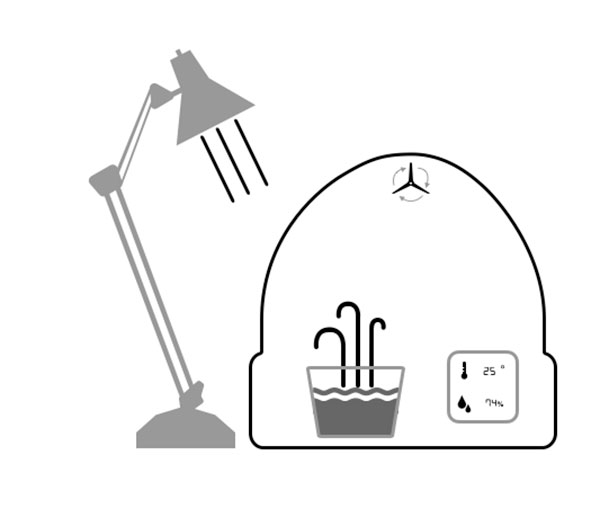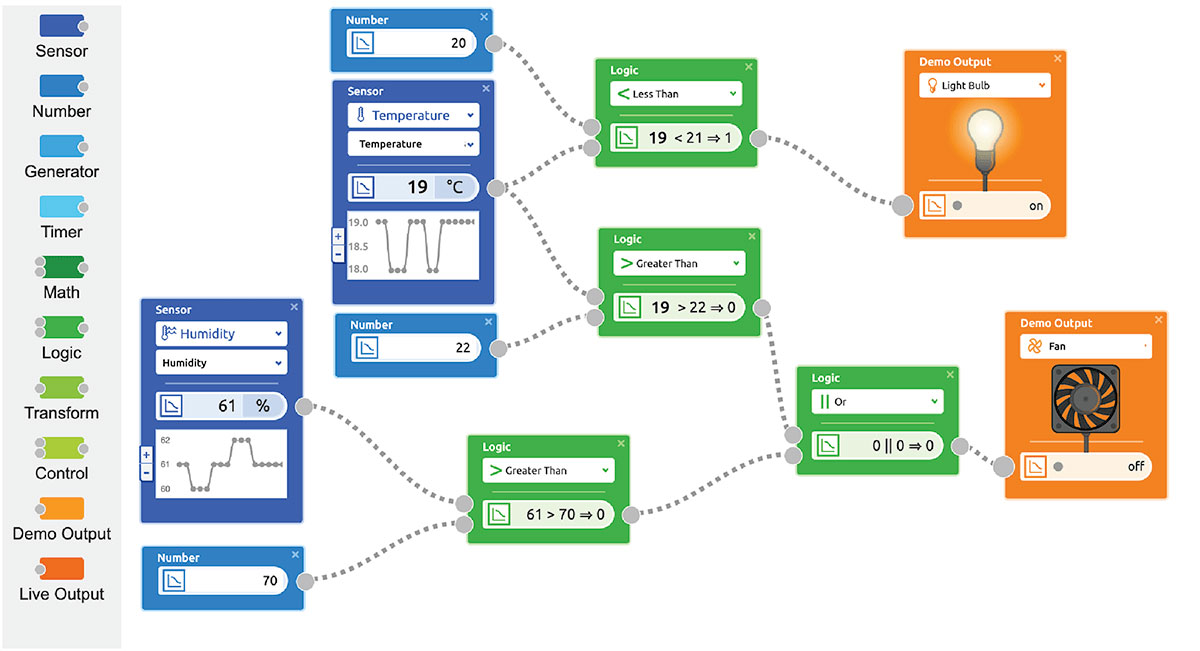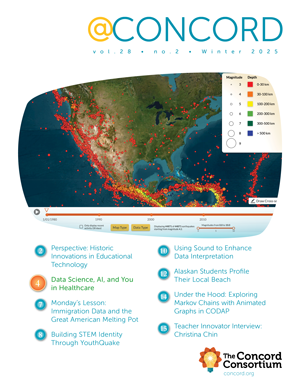Systems Engineering: Design Challenges for the Internet of Things
In the classic egg drop challenge, students use cardboard, tissue paper, balloons, and more to protect poor Humpty Dumpty from a fall. Other early engineering design challenges include constructing a bridge with popsicle sticks or creating a geometric structure with toothpicks and marshmallows. While such activities can help students learn about design, they differ markedly from the challenges of current real-world engineering. The SEE-IT (Science and Engineering Education for Infrastructure Transformation) project leverages the modern-day Internet of Things to engage students in thinking about design from a systems perspective.
According to industry experts, we currently sit in the midst of the fourth industrial revolution. Termed Industry 4.0 (or 4IR), this era is characterized by a confluence of connectivity, data and analytics, automation, and advanced manufacturing technology. Prime among its elements is the Internet of Things (IoT), the under-the-radar network of devices in appliances, manufacturing plants, packaging, and shipping containers that act in concert to power this revolution. Such devices monitor and collect data on processes and conditions all over the world, relaying it to enormous central networks for analysis. The resulting hum of activity forms the heartbeat of the changes sweeping modern industry. Broadly deployed networks of IoT devices enable corporations to sense problems and failures proactively, adjust smart manufacturing processes to fluctuating consumer demand, and control conditions across global supply chains or within individual smart buildings.
Systems engineering and the Fourth Revolution
Introducing advanced, technology-laden scenarios demands the development of new processes, analyses, and methods of response. As the industrial world navigates the complex shift to a 4IR mindset, education must engage students in similar thinking. In doing so, the key principle of systems engineering assumes center stage.
A simple concept with complex ramifications, systems engineering involves designing and managing interactions within systems of interconnected components. Implementing it in the classroom poses true challenges for teaching and learning. For one, systems thinking and systems engineering represent significant departures from the curriculum of many standard engineering classes. Engineered systems involve multiple components, all of which can operate independently and in reaction to local conditions. As a result, these components combine to form complex systems—with all the complicated emergent phenomena, such as feedback loops, inherent to them.
Systems engineering in SEE-IT
The SEE-IT project aims to engage students with systems engineering through the lens of IoT devices and networking, providing them crucial experiences with concepts and components essential to the ongoing shifts in the world of industry and infrastructure. By monitoring a network of interconnected sensors and triggering controllable actuators via remotely delivered electronic signals, students learn to see the world not only as something from which they can actively gather data, but also as something they can react to themselves.
In one example system, students monitor and control the temperature and humidity within a plastic enclosure (Figure 1), which mimics applications ranging from greenhouse-like agricultural scenarios to office building HVAC systems. They make decisions about how to maintain an optimal system state, or how to change conditions to achieve a new desired state.

Students use Dataflow, our node-based visual data programming environment, to create programs that monitor and react to external streams of data in real time (Figure 2). By expressing data streams visibly within a programming environment, Dataflow enables students to imagine and respond to them as entities in themselves. Encoding their thinking and responses within a programmatic artifact allows students to present their design patterns in observable and iterable fashion. Because the code is visual and easily shared, students can exchange code designs with others and discuss the reasoning behind them.
The Dataflow environment design also makes it easy to introduce new layers of complexity. Students may initially encounter a single temperature sensor and heat lamp. Later, they may face situations involving a humidity sensor and humidifier, or decide to add an exhaust fan to exchange the air in the microbiome.

Figure 2. A Dataflow program designed to stabilize temperature and humidity conditions within a remote environment.
Systems of systems
To help students appreciate the nature of complex systems design, SEE-IT enables students to connect multiple enclosed microbiomes to form a combined, multi-enclosure system (Figure 3). Such an extension makes feedback and control loops highly relevant. For example, two groups may have designed Dataflow programs to maintain different temperature and humidity conditions within their individual enclosures. By combining the two enclosures, however, the groups may find their actuators working in a two-party iterating loop targeting an ever-elusive equilibrium or in an escalating “bidding war” endlessly trying to raise their enclosure’s temperature or humidity.

Such examples drive home the fraught nature of attempting to control complex systems and shed useful light on similar behaviors seen in real-world systems, from cruise control systems in cars to thermostats in buildings, and in automation anomalies such as bot-driven online pricing wars. By introducing the intent of other individuals and groups as a key factor, they also highlight the vital importance of considering social interactions when seeking systems engineering solutions.
Virtual systems as well as physical systems
In the SEE-IT project, the use of IoT devices offers a final system-based layer for students to encounter. Because communication with their enclosure happens via remote microcontroller boards (currently moderated via micro:bit devices), students gain firsthand experience with digital systems networking and communication.
In the scenario described above, individual students or groups directly control actuators within one enclosed microbiome. To communicate with that system, however, they send messages across a digital network comprising all micro:bits within the class- room. Arranged to act as part of a mesh network, each micro:bit passes all messages it receives to its nearest neighbor, creating a constant flow of messages across the classroom. Because data about every enclosure passes across all devices in the network, students can monitor conditions within other groups’ microbiomes as well as their own. In situations where multiple enclosures are connected together, students can use this information to design programs that maximize efficiency.
For example, students may recognize that after connecting two enclosures, their existing algorithm—designed for a single isolated enclosure—“fights” a similar algorithm from the opposing group. Students who adjust both algorithms to instead target the average between their goal temperature and the other enclosure’s current temperature may discover they have generated a more efficient solution. Alternatively, students may leverage the properties of digital networking systems themselves by distributing their enclosures across the classroom to attempt to pass signals from one micro:bit to another across a large distance, arranging enclosures to test the efficiency of hub-and-spoke configurations, or using one enclosure and its micro:bit as a repeater bridge to connect networks in two separate classrooms.
By employing simple, observable setups that evoke complex computing ideas and exposing students to such ideas using a programming environment that welcomes student collaboration, we have the opportunity to make complicated ideas such as signal encoding and communications networking tangible and relevant to students. By engaging with IoT devices, systems engineering challenges, and modern design scenarios, students build their ability and confidence for working with interactive, connected systems central to the fourth industrial revolution.
Chad Dorsey (cdorsey@concord.org) is President and CEO of the Concord Consortium.
This material is based upon work supported by the National Science Foundation under grant DRL-2131097. Any opinions, findings, and conclusions or recommendations expressed in this material are those of the author(s) and do not necessarily reflect the views of the National Science Foundation.

